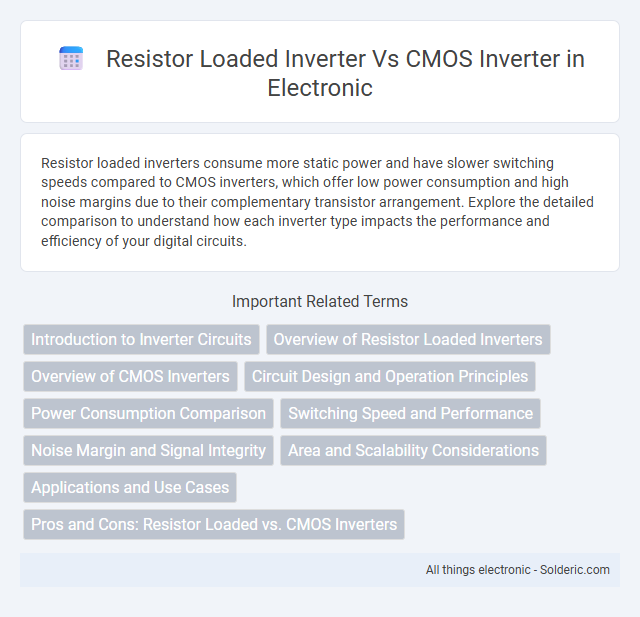Resistor loaded inverters consume more static power and have slower switching speeds compared to CMOS inverters, which offer low power consumption and high noise margins due to their complementary transistor arrangement. Explore the detailed comparison to understand how each inverter type impacts the performance and efficiency of your digital circuits.
Comparison Table
| Feature | Resistor Loaded Inverter | CMOS Inverter |
|---|---|---|
| Technology | Bipolar / NMOS with resistor | Complementary MOS (PMOS + NMOS) |
| Power Consumption | High static power due to resistor | Low static power; power only during switching |
| Noise Margin | Lower noise margin | Higher noise margin |
| Speed | Slower due to resistive load | Faster switching speed |
| Output Voltage Swing | Limited, not rail-to-rail | Full CMOS rail-to-rail swing |
| Complexity | Simple design, uses passive resistor | More complex, needs complementary transistors |
| Area | Smaller transistor area but needs resistor | More transistor area, no external resistor |
| Applications | Simple logic circuits, low-cost designs | High performance and low power digital ICs |
Introduction to Inverter Circuits
Inverter circuits are fundamental components in digital electronics, converting input signals to their logical opposites. Resistor loaded inverters utilize a passive resistor to bias the transistor, resulting in simpler design but higher power consumption and slower switching speeds. CMOS inverters employ complementary MOSFETs, offering low static power dissipation, higher noise margins, and faster switching characteristics, making them the preferred choice for modern integrated circuits.
Overview of Resistor Loaded Inverters
Resistor loaded inverters use a resistor to provide the load, resulting in a simple design with limited switching speed and higher power consumption compared to CMOS inverters. This type of inverter typically suffers from significant static power dissipation due to continuous current flow through the resistor when the output is low. Your choice between resistor loaded and CMOS inverters depends on power efficiency, speed requirements, and circuit complexity.
Overview of CMOS Inverters
CMOS inverters consist of complementary pairs of p-type and n-type MOSFETs, offering high noise margins and low static power consumption due to minimal current flow in steady states. Unlike resistor loaded inverters, CMOS inverters provide full voltage swing output and better switching speed, enhancing overall circuit efficiency. Your integrated circuits benefit from CMOS inverters' scalability and reduced power dissipation in modern digital design applications.
Circuit Design and Operation Principles
A resistor loaded inverter uses a simple resistor as a load element in series with a transistor, resulting in slower switching speeds and higher static power consumption due to continuous current flow when the transistor is on. In contrast, a CMOS inverter employs complementary p-type and n-type MOSFETs that switch alternately, minimizing power usage by eliminating direct current paths during steady states and enabling faster transitions. Your choice impacts overall circuit efficiency, speed, and power dissipation based on these fundamental design and operational differences.
Power Consumption Comparison
Resistor loaded inverters consume significantly more static power due to continuous current flow through the resistor when the output is low, resulting in higher power dissipation. CMOS inverters exhibit much lower power consumption, primarily drawing power only during switching events because of their complementary transistor arrangement that minimizes static current. Your choice of inverter impacts overall circuit efficiency, with CMOS inverters favored in low-power applications for their superior energy-saving capabilities.
Switching Speed and Performance
CMOS inverters exhibit significantly faster switching speeds compared to resistor loaded inverters due to their complementary transistor arrangement minimizing power dissipation during transitions. Resistor loaded inverters suffer from slower rise times and increased static power consumption as the resistor continuously draws current when the output is high. Your designs benefit from CMOS inverters' superior performance, offering higher noise margins, lower power usage, and enhanced switching efficiency in modern digital circuits.
Noise Margin and Signal Integrity
Resistor loaded inverters exhibit lower noise margins compared to CMOS inverters due to their inherent voltage drop and limited drive strength, which leads to degraded signal integrity under noise disturbances. CMOS inverters provide higher noise margins by maintaining rail-to-rail output voltage levels, ensuring robust switching and minimal signal degradation. The superior signal integrity of CMOS inverters makes them the preferred choice in digital circuits requiring high noise immunity and precise logic level representation.
Area and Scalability Considerations
Resistor loaded inverters occupy significantly more chip area compared to CMOS inverters due to the physical size of resistors and their larger process variability impact. CMOS inverters demonstrate superior scalability with shrinking technology nodes, benefiting from smaller transistor sizes and reduced power consumption, making them ideal for high-density integrated circuits. Your design will benefit from CMOS inverters when aiming for compact layouts and efficient scaling in modern semiconductor fabrication.
Applications and Use Cases
Resistor loaded inverters are commonly used in low-frequency analog circuits and simple digital logic where cost and simplicity are prioritized, such as in educational demonstrations and basic signal inversion tasks. CMOS inverters dominate modern digital applications, including microprocessors, memory devices, and high-speed logic circuits, due to their low power consumption and high noise immunity. Your choice between these inverter types depends on the specific requirements for power efficiency, speed, and circuit complexity in your application.
Pros and Cons: Resistor Loaded vs. CMOS Inverters
Resistor loaded inverters offer simpler design and lower fabrication costs but suffer from increased power dissipation and slower switching speeds compared to CMOS inverters. CMOS inverters provide high noise immunity, low static power consumption, and faster operation, making them ideal for modern integrated circuits despite higher manufacturing complexity. The trade-off involves balancing resistor loaded inverter's simplicity against CMOS inverter's performance efficiency and scalability in VLSI applications.
Resistor loaded inverter vs CMOS inverter Infographic

 solderic.com
solderic.com